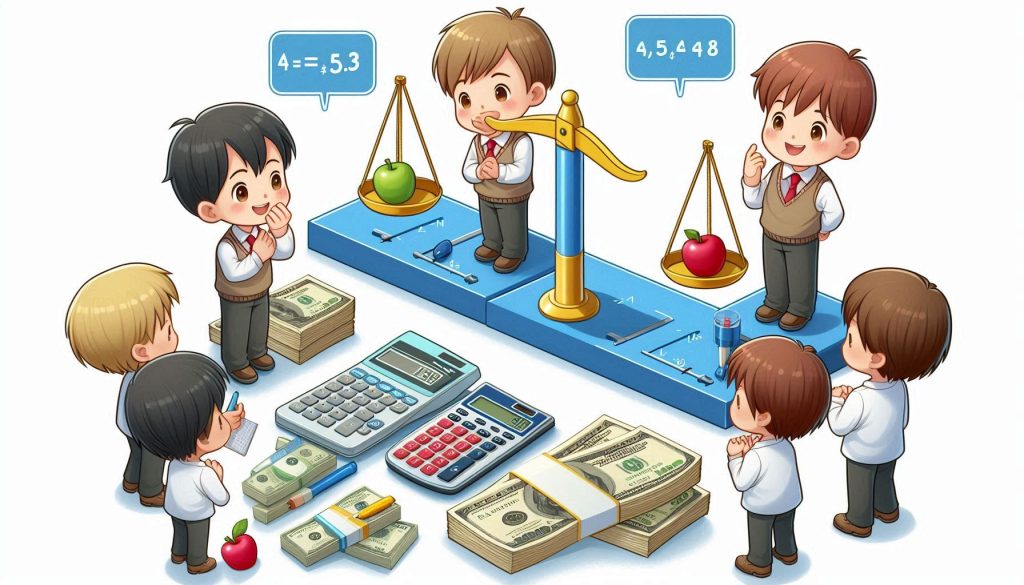Comparing Quantities – Complete Guide For Class 7 Math Chapter 7
Welcome to iPrep, your Learning Super App. Our learning resources for the chapter, Comparing Quantities in Mathematics for Class 7th Chapter 7 are designed to ensure that you grasp this concept with clarity and perfection. Whether you’re studying for an upcoming exam or strengthening your concepts, our engaging animated videos, practice questions and notes offer you the best of integrated learning with interesting explanations and examples.
The chapter on Comparing Quantities is designed to build a solid foundational understanding of ratios, proportions, and percentages. These concepts are critical in mathematics, forming the basis for more complex topics and real-life applications. This chapter aims to introduce students to the comparison of quantities through ratios and proportions, the conversion between fractions, decimals, and percentages, and the calculation of profit, loss, and interest, ensuring they grasp the fundamental principles required for higher-level math and practical problem-solving in everyday life.
Comparing Quantities

Basic Definitions
Comparing quantities involves evaluating two or more amounts to determine their relationship in terms of size, value, or magnitude.
Equivalent Ratios
Comparing quantities further involves equivalent ratios. The definition of the same is-
Definition: Equivalent ratios are two or more ratios that express the same relationship between numbers.
Key Points to check if ratios are equivalent, follow these steps:
- Write the ratios in the form of fractions.
- Compare them by converting them to like fractions.
- If the like fractions are equal, the given ratios are equivalent.
Unitary Method for Proportions
The chapter comparing quantities also involves the concept of unitary method which involves finding the value of a single unit first and then the value of the required number of units. This method helps in keeping things in proportion.
Example: If 2 carry bags can contain 6 kg of vegetables, how many bags are needed for 24 kg?
Solution: Bags required for 6 kg = 2,
Bags required for 1 kg = 2/6 = 1/3,
Bags required for 24 kg = (1/3) x 24 = 8 bags.
Thus, 24 kg of vegetables will require 8 bags.
Percentage
The chapter comparing quantities also involves the understanding of Percentages. A percentage is a way of expressing a number as a fraction of 100. It shows how large one quantity is relative to another.
Example: 45% (read as “forty-five percent”) is equal to 45/100 or 0.45.
- Converting Fractions to Percentage
To convert fractions to percentages:
- Convert the fraction to a common denominator of 100.
- Simplify the fraction to find the percentage.
Examples:
- 4/5 = 4/5 ×100/ 100 = 4/5 x 100% = 400 %/5 = 80%
- 7/8 = 7/8 × 100/100 = 7/8 x 100% = 700%/8 = 87.5%
- Converting Decimals to Percentage
To convert decimals to percentages, multiply the decimal by 100.
Examples:
- 4.05 = 4.05 × 100% = 405/100 x 100% = 405%
- 25.5 = 25.5 × 100 = 255/10 x 100% = 2550%
- Converting Percentages to Fractions or Decimals
To convert percentages to fractions or decimals, divide by 100.
Examples:
- 19% = 19/100 = 0.19
- 400% = 400/100 = 4
- Converting Ratios to Percentage
To convert ratios to percentages, first convert the ratio to a fraction and then to a percentage.
Example: For the ratio 4:5
Solution: Total parts = 4 + 5 = 9
Percentage of 4 = 4/(4+5) × 100 = 4/9 x 100 = 44.45%
Percentage of 5 = 5/(4+5) = 5/9 x 100 = 55.55%
Finding the Increase/Decrease Percent
The chapter comparing quantities also covers finding the increase and decrease percent. the formula of the same is given below:
Formula: Percent Increase / Decrease = (Amount of Change / Original Amount) × 100
Examples:
- Radha’s marks decreased from 70 to 50.
Decrease percent = (Amount of Change / Original Amount) × 100
= (20/70) × 100 = 28.57%
- Ridhi’s marks increased from 70 to 80.
Increase percent = (Amount of Change / Original Amount) × 100
= (10/70) × 100 = 14.28%
Buying & Selling
Definitions:
- Cost Price (C.P): The price at which an article is bought.
- Selling Price (S.P): The price at which an article is sold.
Profit and Loss
Definitions:
- Profit: Whenever a shopkeeper sells an item so that the Selling price is more than the Cost price, he earns a profit.
Profit = S.P−C.P
- Loss: Whenever a shopkeeper sells an item so that the Cost price is more than the Selling price,he suffers a loss.
Loss = C.P−S.P
Formulas:
- Profit Percent: Profit % = (Profit / C.P) × 100
- Loss Percent: Loss % = (Loss / C.P) × 100
Example: A jacket with a cost price of ₹ 1000 was sold for ₹ 750.
- Loss = ₹ 1000 – ₹ 750 = ₹ 250
- Loss% = (250 / 1000) × 100 = 25%
Interest
Definition: Interest is the extra money paid by borrowers or earned on deposits.
Simple Interest (SI): SI = (Principal × Rate of Interest × Time / 100)
Amount = Principle + Simple Interest
Example: Find the amount to be paid on ₹ 7500 at 3.5% p.a. for 1 year.
Solution: SI = (7500 × 3.5 × 1/ 100) = ₹ 262.50.
Total amount = Principal + SI = ₹ 7500 + ₹ 262.50 = ₹ 7762.50
In conclusion, Chapter 6: Comparing Quantities is a crucial part of the Class 7 Math curriculum, offering students a strong foundation in understanding ratios, proportions, percentages, profit and loss, and simple interest. These concepts are not only vital for academic success but also have practical applications in daily life, from budgeting to shopping. At iPrep, we ensure that students grasp these concepts thoroughly with our engaging learning resources, including animated videos, practice questions, and comprehensive notes. By mastering this chapter, students are well-equipped to tackle more advanced mathematical topics with confidence.
Practice questions on Chapter 7 - Comparing Quantities
Get your free Chapter 7 - Comparing Quantities practice quiz of 20+ questions & detailed solutions
Practice Now








